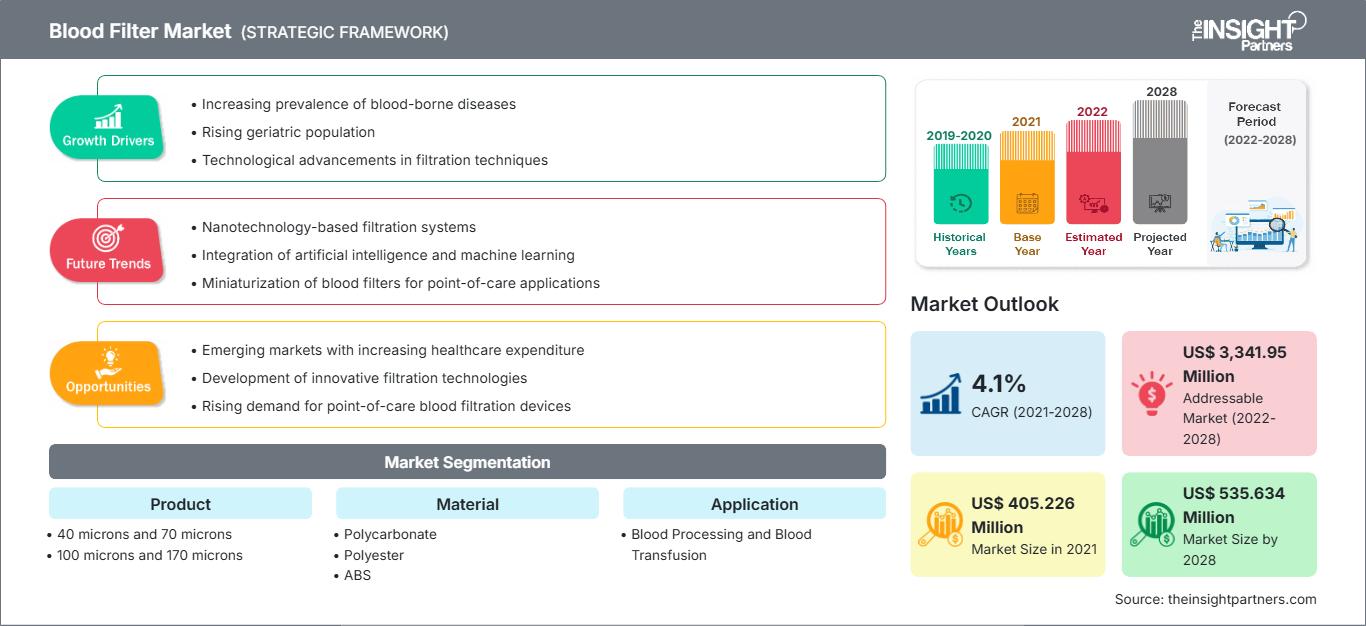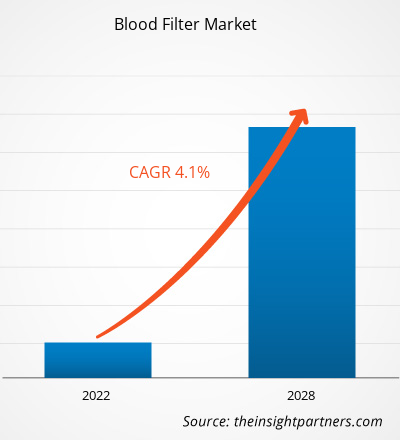Der Markt für Blutfilter soll von 405,226 Millionen US-Dollar im Jahr 2021 auf 535,634 Millionen US-Dollar im Jahr 2028 anwachsen; von 2021 bis 2028 wird ein CAGR-Wachstum von 4,1 % erwartet.
Ein Blutfilter ist ein siebartiger Filter aus gewebtem Polyester- oder Nylongewebe, der zur Filtration zwischen Produktbeutel und Patient platziert wird. Diese Filter sollen Patienten vor Makroaggregaten und nicht aus Blut bestehenden Partikeln schützen, die gefährlich werden könnten, wenn sie in den Blutkreislauf gelangen. Sie entfernen Makroaggregate wie Mikroaggregate und Fibrinaggregate während einer Bluttransfusion. Bei der Filtration werden Partikel und Makroaggregate aus Leukozyten, Fibrin und Blutplättchen, die während der Blutlagerung gebildet werden, aufgefangen. Faktoren wie die zunehmende Belastung durch chronische Krankheiten, ein Anstieg der Trauma- und Unfallfälle sowie eine steigende Zahl von Bluttransfusionen treiben das Wachstum des Blutfiltermarktes voran. Produktrückrufe hemmen jedoch das Marktwachstum.
Passen Sie diesen Bericht Ihren Anforderungen an
Sie erhalten kostenlos Anpassungen an jedem Bericht, einschließlich Teilen dieses Berichts oder einer Analyse auf Länderebene, eines Excel-Datenpakets sowie tolle Angebote und Rabatte für Start-ups und Universitäten.
Markt für Blutfilter: Strategische Einblicke

- Holen Sie sich die wichtigsten Markttrends aus diesem Bericht.Dieses KOSTENLOSE Beispiel umfasst Datenanalysen, die von Markttrends bis hin zu Schätzungen und Prognosen reichen.
Sie erhalten kostenlos Anpassungen an jedem Bericht, einschließlich Teilen dieses Berichts oder einer Analyse auf Länderebene, eines Excel-Datenpakets sowie tolle Angebote und Rabatte für Start-ups und Universitäten.
Markt für Blutfilter: Strategische Einblicke

- Holen Sie sich die wichtigsten Markttrends aus diesem Bericht.Dieses KOSTENLOSE Beispiel umfasst Datenanalysen, die von Markttrends bis hin zu Schätzungen und Prognosen reichen.
Markteinblicke
Steigende Zahl von Bluttransfusionen fördert Wachstum des Blutfiltermarktes
Die Verbesserung der Verfügbarkeit von sicherem und ausreichendem Blut für Transfusionen sollte fester Bestandteil der Gesundheitspolitik und -infrastruktur jedes Landes sein. Bluttransfusionen können in städtischen und ländlichen Gebieten jederzeit erforderlich werden. In der Vergangenheit hat die Nichtverfügbarkeit von Blut zum Tod vieler Patienten mit gesundheitlichen Problemen geführt. Eine ausreichende und zuverlässige Versorgung mit sicherem Blut kann durch stabile Einrichtungen für regelmäßige, freiwillige und unbezahlte Blutspender sichergestellt werden. Sie sind zudem die sicherste Spendergruppe, da die Prävalenz von durch Blut übertragbaren Infektionen unter diesen Spendern am niedrigsten ist.
Zu den häufigsten Operationen, die eine Bluttransfusion erfordern, gehören Herz-Kreislauf-Eingriffe, Kaiserschnitte und Verletzungen. Nach Schätzungen des National Heart, Lung, and Blood Institute und der National Institutes of Health (NIH) benötigen in den USA jährlich über 5 Millionen Menschen Bluttransfusionen. Aufgrund von Naturkatastrophen und weitverbreiteten Todesopfern steigt der Bedarf an Bluttransfusionen zudem weltweit an. Ein sprunghafter Anstieg von Bluterkrankungen wie Anämie, Erythrozytose, Leukozytose, Leukopenie und Thrombozytose treibt das Wachstum des Blutfiltermarktes ebenfalls an. Laut WHO werden die meisten Kinder mit Thalassämie in Ländern mit niedrigem Einkommen geboren, in denen der Zugang zu Bluttransfusionen entweder schwierig ist oder nur einem kleinen Prozentsatz der Bevölkerung zur Verfügung steht.
Die bei Transfusionsverfahren verwendeten Blutfilter bestehen aus gewebten Netzen aus Polyester oder Nylon. Diese siebartigen Filter werden zwischen dem Produktbeutel und dem Patienten platziert. Diese Filter sollen die Patienten vor potenziell schädlichen Makroaggregaten wie Blutplättchen, Leukozyten und Fibrinproteinen sowie vor Partikeln, die nicht zum Blut gehören, schützen. In den meisten Industrieländern werden Bluttransfusionsfilter von Regierungen oder gemeindebasierten Programmen bereitgestellt. Die Verfügbarkeit geeigneter Einrichtungen für Blutspenden und freiwillige Spender treibt somit die Anzahl der Bluttransfusionen an, was das Wachstum des Marktes für Blutfüllstoffe fördert.
Produktbasierte Erkenntnisse
Nach Produkten ist der Blutfiltermarkt weiter segmentiert in 40 Mikrometer und 70 Mikrometer, 100 Mikrometer und 170 Mikrometer und andere. Das Segment 100 Mikrometer und 170 Mikrometer dürfte 2021 den größten Marktanteil halten und im Prognosezeitraum voraussichtlich eine höhere durchschnittliche jährliche Wachstumsrate verzeichnen.
Materialbasierte Erkenntnisse
Nach Materialien ist der Blutfiltermarkt in Polycarbonat, Polyester, ABS und andere segmentiert. Das Polyestersegment dürfte 2021 mit 35,47 % den größten Marktanteil halten und wird seine beherrschende Stellung im Prognosezeitraum voraussichtlich beibehalten.
Anwendungsbasierte Erkenntnisse
Basierend auf der Anwendung ist der Blutfiltermarkt in Blutverarbeitung und Bluttransfusion segmentiert. Das Bluttransfusionssegment dürfte 2021 mit 73,83 % den größten Marktanteil halten und wird seine beherrschende Stellung im Prognosezeitraum voraussichtlich beibehalten.
Endbenutzerbasierte Erkenntnisse
Basierend auf dem Endbenutzer ist der Blutfiltermarkt in Blutbanken, Krankenhäuser und andere segmentiert. Das Segment Blutbanken dürfte im Jahr 2021 mit 47,38 % den größten Marktanteil halten und wird seine beherrschende Stellung im Prognosezeitraum voraussichtlich beibehalten.
Verschiedene auf dem Blutfiltermarkt tätige Unternehmen verfolgen Strategien wie Produkteinführungen, Fusionen und Übernahmen, Kooperationen, Produktinnovationen und Produktportfolioerweiterungen, um ihre Präsenz weltweit auszubauen, den Markennamen zu wahren und die wachsende Nachfrage der Endverbraucher zu befriedigen.
Markt für Blutfilter
Die Analysten von The Insight Partners haben die regionalen Trends und Faktoren, die den Blutfiltermarkt im Prognosezeitraum beeinflussen, ausführlich erläutert. In diesem Abschnitt werden auch die Marktsegmente und die geografische Lage in Nordamerika, Europa, dem asiatisch-pazifischen Raum, dem Nahen Osten und Afrika sowie Süd- und Mittelamerika erörtert.Umfang des Marktberichts zu Blutfiltern
| Berichtsattribut | Einzelheiten |
|---|---|
| Marktgröße in 2021 | US$ 405.226 Million |
| Marktgröße nach 2028 | US$ 535.634 Million |
| Globale CAGR (2021 - 2028) | 4.1% |
| Historische Daten | 2019-2020 |
| Prognosezeitraum | 2022-2028 |
| Abgedeckte Segmente |
By Produkt
|
| Abgedeckte Regionen und Länder | Nordamerika
|
| Marktführer und wichtige Unternehmensprofile |
|
Dichte der Marktteilnehmer für Blutfilter: Verständnis ihrer Auswirkungen auf die Geschäftsdynamik
Der Blutfiltermarkt wächst rasant, angetrieben durch die steigende Endverbrauchernachfrage aufgrund von Faktoren wie sich entwickelnden Verbraucherpräferenzen, technologischem Fortschritt und einem stärkeren Bewusstsein für die Produktvorteile. Mit steigender Nachfrage erweitern Unternehmen ihr Angebot, entwickeln Innovationen, um den Verbraucherbedürfnissen gerecht zu werden, und nutzen neue Trends, was das Marktwachstum weiter ankurbelt.

- Holen Sie sich die Markt für Blutfilter Übersicht der wichtigsten Akteure
Markt für Blutfilter – nach Produkt
- 40 Mikrometer und 70 Mikrometer
- 100 Mikrometer und 170 Mikrometer
- Andere
Markt für Blutfilter – nach Material
- Polycarbonat
- Polyester
- ABS
- Andere
Markt für Blutfilter – nach Anwendung
- Blutverarbeitung
- Bluttransfusion
Markt für Blutfilter – nach Endbenutzer
- Blutbanken
- Krankenhäuser
- Andere
Blutfiltermarkt – nach Geografie
- Nordamerika
- USA
- Kanada
- Mexiko
- Europa
- Frankreich
- Deutschland
- Italien
- Vereinigtes Königreich
- Spanien
- Übriges Europa
- Asien-Pazifik (APAC)
- China
- Indien
- Südkorea
- Japan
- Australien
- Übriger Asien-Pazifik-Raum
- Naher Osten und Asien Afrika (MEA)
- Südafrika
- Saudi-Arabien
- VAE
- Rest des Nahen Ostens und Afrikas
- Süd- und Mittelamerika (SCAM)
- Brasilien
- Argentinien
- Rest von Süd- und Mittelamerika
Firmenprofile
- Asahi Kasei Corporation
- Fresenius Kabi AG
- Macopharma
- Haemonetics Corporation
- Infomed SA
- KANEKA CORPORATION
- Kawasumi laboratories. Inc.
- Sefar AG
- Shandong Zhongbaokang Medical Implements Co., Ltd.
- Nanjing Shuangwei Biotechnology Co., Ltd.
- Historische Analyse (2 Jahre), Basisjahr, Prognose (7 Jahre) mit CAGR
- PEST- und SWOT-Analyse
- Marktgröße Wert/Volumen – Global, Regional, Land
- Branchen- und Wettbewerbslandschaft
- Excel-Datensatz
Aktuelle Berichte
Verwandte Berichte
Erfahrungsberichte
Grund zum Kauf
- Fundierte Entscheidungsfindung
- Marktdynamik verstehen
- Wettbewerbsanalyse
- Kundeneinblicke
- Marktprognosen
- Risikominimierung
- Strategische Planung
- Investitionsbegründung
- Identifizierung neuer Märkte
- Verbesserung von Marketingstrategien
- Steigerung der Betriebseffizienz
- Anpassung an regulatorische Trends






















 Kostenlose Probe anfordern für - Markt für Blutfilter
Kostenlose Probe anfordern für - Markt für Blutfilter